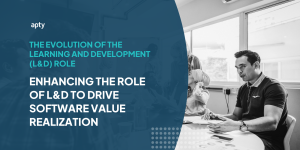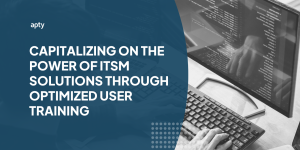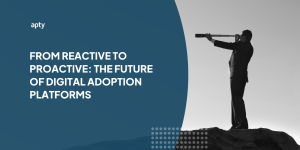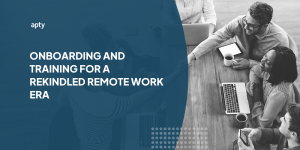While companies ranging from Amazon to Roblox to Lyft and others are making headlines for their back-to-office mandates, the reality is that remote work (or working from home, also known as WFH) isn’t going away. In fact, today, most remote-capable employees expect to work hybrid or fully remote. This is forcing organizations to reconsider the way they onboard and train new employees, especially those working away from the office.
The cost to an organization of not adequately onboarding both onsite and remote employees is high. New hires are most prone to leaving within the first three months on the job, and the impact of this level of churn is far-reaching. In fact, the average cost of hiring a new full-time employee is almost $5,000, and this does not include the disruption to the organization, which is often considerable.
Much of the high churn rate can be attributed to insufficient software training and adoption, which impacts people who work from home disproportionately. In fact, remote workers report feeling more undertrained and disoriented after onboarding than their on-site or hybrid counterparts. For this reason, an extra special level of care must go into designing training specifically for the needs of remote workers, including:
Offering ‘Micro-Learning’ Options

Micro-learning is a term often used to refer to a set of compact e-learning modules designed to reduce learner fatigue. These can be easily and seamlessly incorporated into learners’ daily routines – making this option ideal for remote workers trying to juggle meetings and home life tasks.
In a micro-learning model, information is spaced out, delivered in smaller bits, and consumed at the remote worker’s convenience. In addition, micro-learning often leverages ‘push’ technology – distributing learning content in short sprints (for example, 3-5 minute short videos, interactive quizzes, or games) in order to reduce the cognitive load on users and increase engagement.
According to one study, organizations using micro-learning have seen a 20 percent increase in employee productivity and a 23 percent increase in employee satisfaction – largely due to increased learner confidence in their ability to understand and apply the training content to their work. Other cognitive science research shows that breaking down large volumes of information into smaller “chunks” can improve learner focus, reduce the potential for overload, and make the material easier to remember – a must for remote workers who want to remain efficient, agile, and in lockstep with their on-site counterparts.
Accommodate the “Forgetting Curve” with Real-Time Learning Content Delivery

At many organizations, training consists of a single, concentrated information dispersal. However, such approaches often fail because they neglect to accommodate the “forgetting curve,” or the fact that most people don’t remember newly-learned information after one week. This forgetfulness isn’t due to laziness or lack of effort on the part of workers; it’s just human nature.
Where remote workers are concerned, it is essential to offer real-time learning content – reminders, alerts, banners, and information bubbles with supporting links or videos – at the moment it might be needed. In addition to helping circumvent the “forgetting curve,” the delivery of learning content in real-time further reinforces the benefits of micro-learning by reducing the cognitive load on users and therefore increasing engagement. In other words, the worker doesn’t have to ponder and ask questions at the point of need; rather, the information is right in front of them, empowering them to be self-directed and independent.
Implementing real-time learning content delivery also ensures that employee engagement remains high. As new employees going through the onboarding process consistently experience this delivery method, they will quickly understand that the company is invested in their performance and training and has implemented processes and systems to help them succeed. With more productive and self-sufficient employees at home and in the office, leadership, in turn, sees the results through revenue increases, reduced support costs, and business process adoption.
Prove Adoption and Value

These days, companies are investing millions into their software applications, and it’s not enough to just assume (or hope) that there will be a positive return on investment (ROI). That’s why it’s vital to embrace a data-driven approach to adoption by tracking activity and analytics that gather key insights on whether and which new employees are using the software. Analytics can also identify the areas that may be blocking remote workers from executing their core tasks. Identifying and addressing these blockers can make the learning experience smoother and more successful.
This is why digital adoption platforms prioritizing software value realization have garnered such traction, and CIOs plan to assist HR departments by deploying such SaaS products on software across the enterprise. In fact, according to Gartner, by 2025, 70 percent of organizations will use digital adoption platforms within their technology stack to overcome still insufficient application user experiences.
Remote workers continue to constitute a significant portion of most organizations’ workforces, and effective onboarding and training for these workers is essential to lowering churn and avoiding wasted hiring costs. By breaking up learning content into smaller chunks via micro-learning, incorporating real-time learning content delivery while measuring learners’ progress, and identifying and proactively addressing problem areas quickly, companies can help remote workers navigate onboarding and training challenges, resulting in improved ROI from their software investments.













